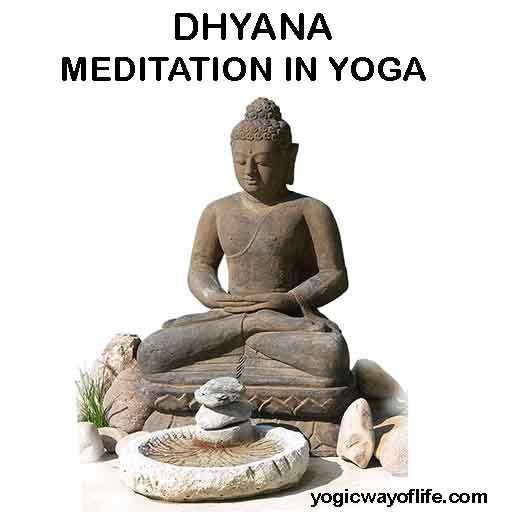Dhyana or meditation in yoga is the 7th stage or step in the eight-limbed Ashtanga Yoga. Dhyana is explained in the Yoga Sutras of Maharishi Patanjali as constant and effortless flow of awareness a point, object or a centre. Dhyana leads to Samadhi or the superconscious state (the 8th Stage of Ashtanga Yoga).

In the 8-fold path of yoga, Dhyana is considered among the internal limbs of yoga (along with Dharana and Samadhi). The internal limbs of yoga are part of Raja Yoga or the royal path to liberation.
In Patanjali Yoga Sutras, Dhyana is described as “tatra pratyaya ekatanata dhyanam”
Here tatra means there.
Pratyaya means to content of mind.
Ekatanata means continuous flow of attention.
Dhyanam means meditation.
So Dhyana can be translated as a continuous, uninterrupted flow of attention towards the object of meditation. In Sanskrit there is another word called Ekagrata, which means one-pointedness; that is the prerequisite for meditation. Meditation starts with concentration. When the concentration becomes continuous over a period of time, the effort drops off. This effortless, one pointed awareness of the object of meditation is Dhyana. If concentration is about focusing, then meditation is about de-focusing; yet maintaining a complete awareness of the object of meditation. This is achieved by developing the art of relaxation while keeping awareness of the object of meditation.
How to do Dhayana or Meditation in Yoga?
The first step is to choose an object of meditation. Dhyana or meditation in yoga can be on any object, external or internal. Externally, it can be a candle flame or a dot on the wall or a picture of your desired deity or any other object like the symbol of Om, cross, star, any yantra, etc. Internally, one can choose to concentrate on internal light at the eyebrow or the heart centre or on one of the energy centres or chakras in the body, or simply on the breath. Or just focus your attention at the tip of the nose or the eye brow centre. One may even concentrate on the sound of a chosen mantra.
Once you have decided on an object for meditation, you have to start with the practice of Pratyahara or withdrawal of the senses from the external sense objects. Once the mind is internalized, then you have to practice Dharana or concentration on your chosen object of meditation using effort and focus. With continued practice, concentration can be maintained for a prolonged period with one-pointed awareness; then it automatically becomes meditation. Meditation happens spontaneously. You cannot forcefully meditate as meditation can happen only in an effortless state.
Dhyana or meditation in yoga is a prelude to Samadhi or experience of super-conscious state.
There are innumerable methods of meditation. Once you have understood, the basic principles of meditation, one may follow any technique that suites our nature.
Benefits of Dhyana or Meditation in Yoga
- Dhyana leads us to the higher state of Samadhi in progressive stages.
- It removes Vikshepa or the agitation of the mind and creates calmness and peace inside.
- Practice of Dhyana improves memory and attention in our day to day activities.
- Dhyana brings forth our hidden creativity. Only a small part of our brain is utilized during our daily activities. Meditation can activate many of the hidden centres to bring out hidden abilities and creative skills.
- According to Patanjali Yoga Sutras, Dhyana on esoteric subjects along with Dharana and Samadhi can give Siddhis or supernatural powers.
- Regular practice of meditation can give good physical health and a sense of well-being.
- Negative emotions like anger and lust can be slowly brought under our control with Dhyana.
- Practice of Dhyana or meditation is an effective way to gain liberation from the bondage of birth and death.
- The peace that one feels during meditation, radiates to others in our daily activities and creates a harmonious society, free of negative thoughts and feelings.

Learning to concentrate on an object is the first step… it is the step I come back to again and again over the years. I like to concentrate within on the third-eye chakra, it really calms me down.